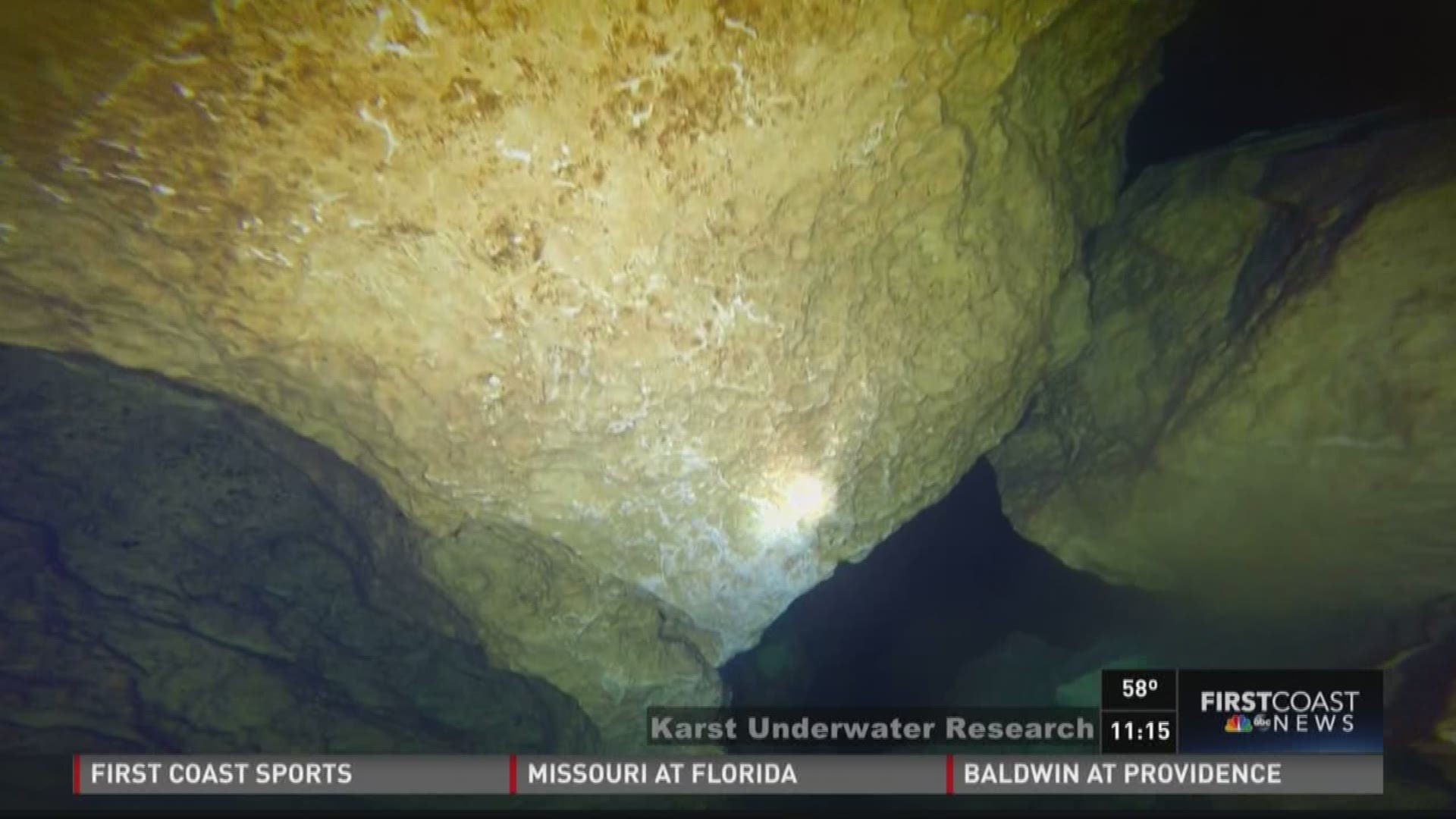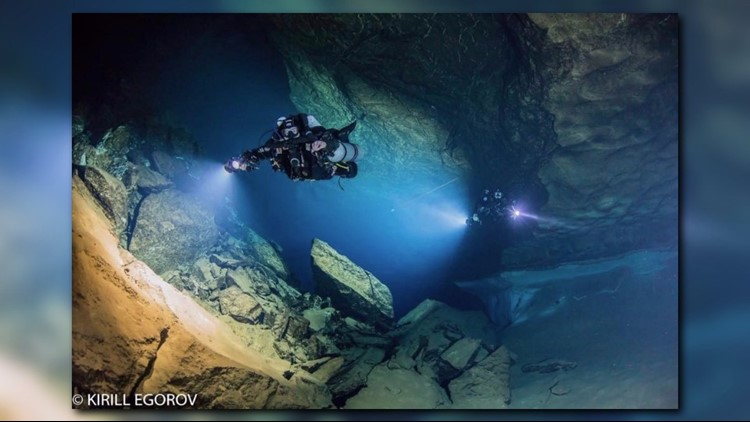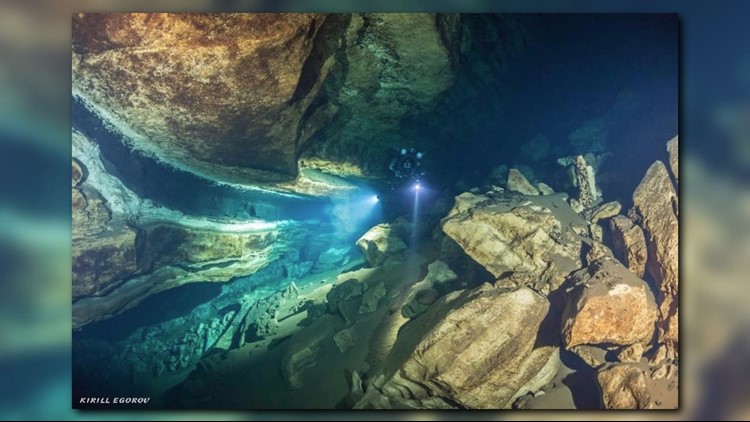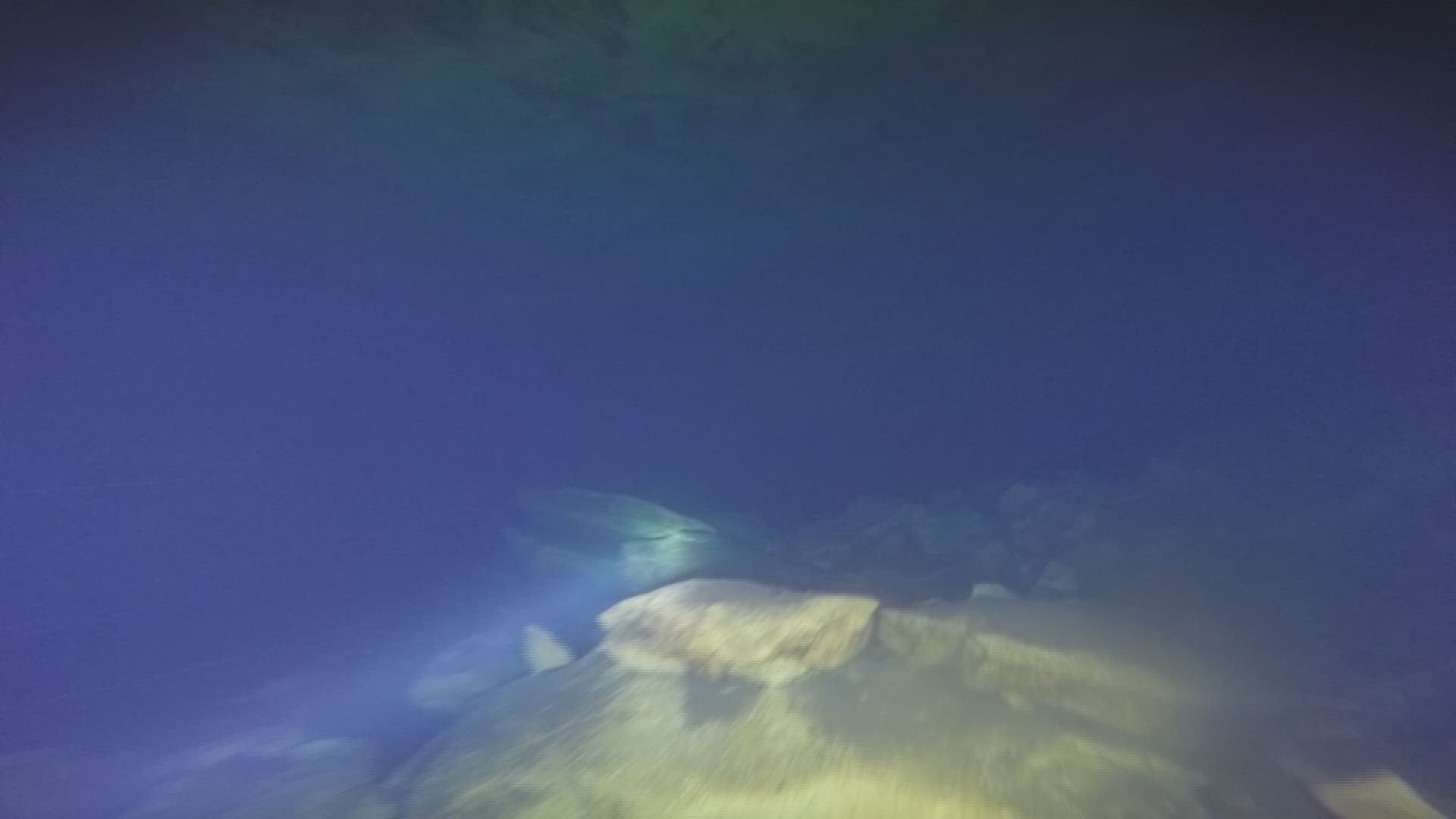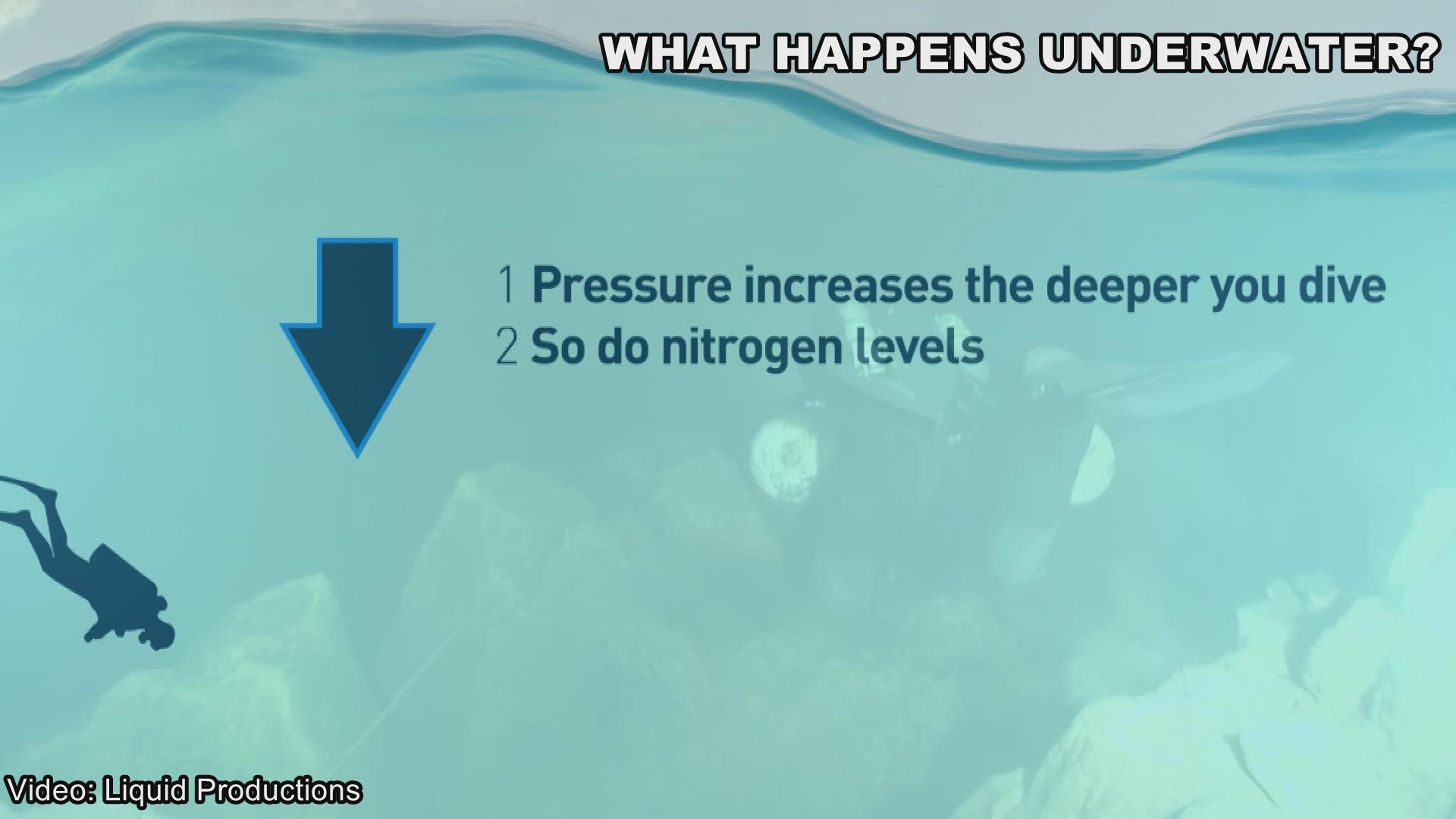"It’s a very primal, primal fear,” Dr. Andrew Pitkin says. “Being in a small space filled with water. It absolutely horrifies people.”
It’s a fear that Pitkin understands, but does not share. He's grown comfortable in some of earth’s most inhospitable places: Underwater caves that are more than 300 feet deep and several miles from any surface opening.
Pitkin is part of a small fraternity of explorer-level cave divers. He and his colleague Brett Hemphill, with the nonprofit Karst Underwater Research group, have mapped miles of previously unexplored caves, scouting the Swiss-cheese architecture of Florida’s underground springs, all while pushing the boundaries of endurance and human imagination.
“It’s a deep dark place,” Pitkin observes. “The typical reaction is, ‘You would never catch me doing that.’”


FLORIDA'S MOST NOTORIOUS CAVE
On a warm winter morning, Pitkin and Hemphill sit on a wooden platform near the entrance to one of Florida's most notorious and lethal caves: Eagle's Nest. Its entrance - a placid pond - looks as benign as a Florida swimming hole.
Located deep in the woods of Hernando County, Eagle's Nest claimed the lives of two experienced divers last October. Last month - just days after the men spoke to First Coast News - another diver was killed, marking the 11th known death at Eagle’s Nest.
“Whenever there’s a cave diving fatality, the general public will go, ‘Oooh, I would never do that! So close it,’” Hemphill notes.
The state did close the site between 1999 to 2003. It was reopened at the urging of divers. However, calls to close it again surfaced after the Christmas 2013 deaths of Darrin Spivey, 35, and his 15-year-old son. The October 2016 deaths of Patrick Peacock and Chris Rittenmeyer, both experienced divers, prompted an online petition urging Florida Fish and Wildlife Conservation Commission to close or regulate it. And on Jan. 8, Charles Odom died while surfacing from a dive.

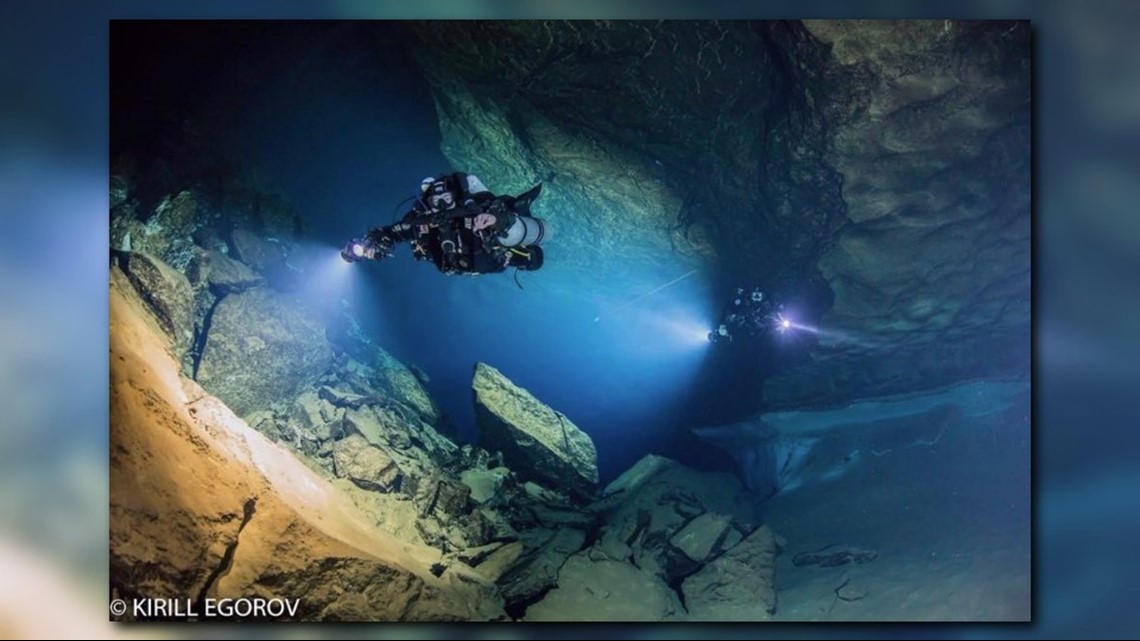
“How many more lives need to be lost for this place to be closed?” asks the Change.org petition.
“It’s natural to want to blame something - ‘the evil cave’ - for what happened,” Pitkin says. “But it’s not appropriate, any more than it’s appropriate to blame a mountain someone falls off.”
Pitkin notes that nearly 300 people have died trying to summit Mount Everest, but nobody is pushing to close that natural wonder.
“They say 'It’s a mountain, what do you expect?” Pitkin says.

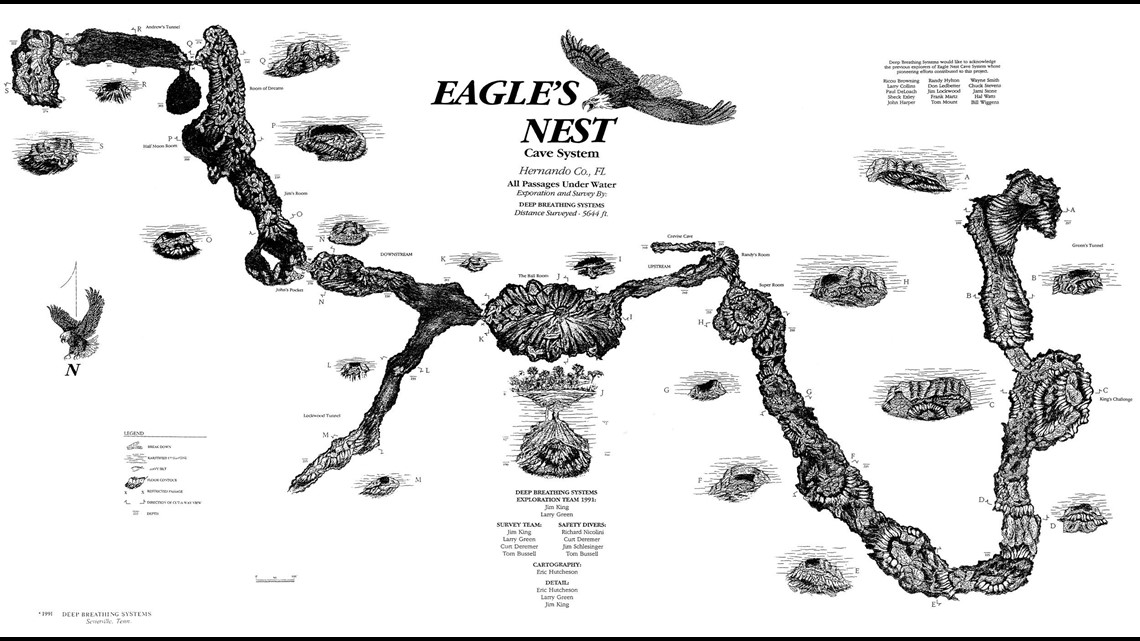
EXPERIENCED DIVERS: THE CAVE IS SAFE WITH PROPER TRAINING
Deadly to some, Eagle’s Nest isn’t even all that challenging to the most experienced divers like Pitkin and Hemphill.
Eagle's Nest sink
“It’s like a stroll in the park for us, really,” Pitkin says. “If you know what you’re doing, it’s as safe as any other cave.”
The problem, they say, is few divers really do know what they’re doing. Caves are not simply “next level” dives for the scuba-certified. The overhead environment of a cave like Eagle's Nest means there is only one way out. That exit can be hard to find, even with a guide wire.
The caves are pitch black. And while some portions are so narrow divers must squeeze through, other sections are large enough to drive a tractor-trailer through. They are also full of rushing water, with currents strong enough that that divers use underwater scooters to pull them along. Every finstroke can kick up silt, turning the crystal-clear caves into blind alleys.

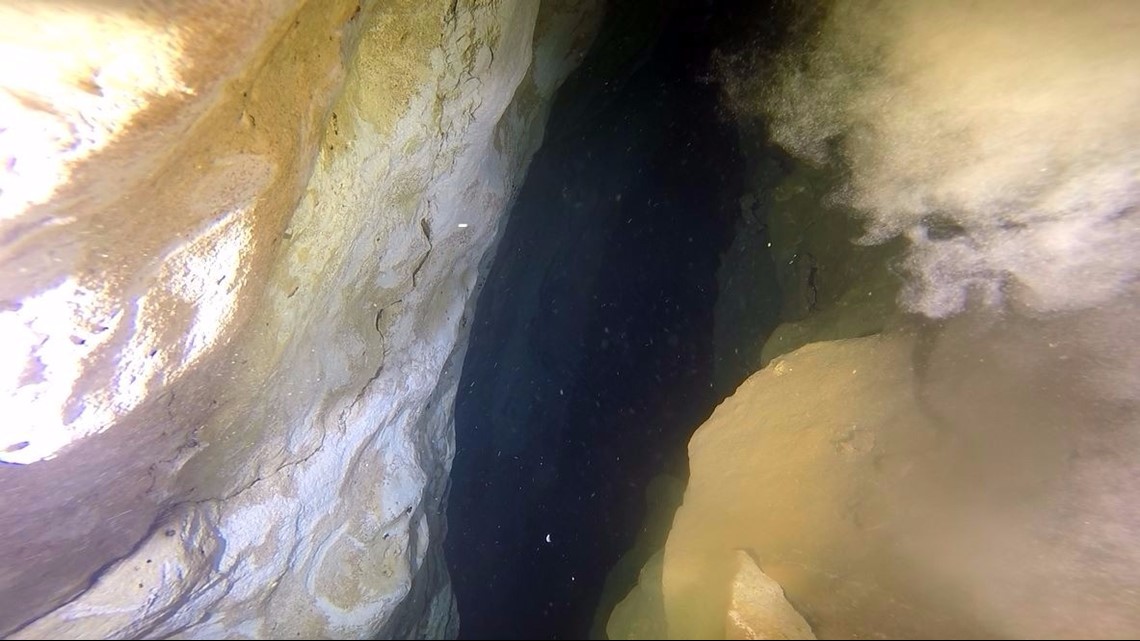
HOURS OF DECOMPRESSION
Divers can also get out of their depth easily, and those using ordinary dive gear (open-circuit scuba) are at risk of nitrogen narcosis, which causes severe mental impairment. Even rising to the surface can be dangerous, so divers must decompress. If not, a quick ascent can cause air bubbles to bloom in the bloodstream, leading to paralysis or even death.
“The best way to explain it is if you have a two-liter bottle of pop," Hemphill explains. "You shake it up, you never see the bubbles because it’s under pressure. But the moment you open the top, you see those bubbles form. We become those vessels underwater.”
To help with decompression, Pitkin and Hemphill use rebreathers, which recycle unused oxygen and add in helium. The so-called closed circuit scuba allows them to stay under for as long as 20 hours. Long dives come with their own hazards – particularly fatigue – and require extended decompression times. Every 15 minutes the divers spend underwater can require a full hour of decompression.
“A dive may only be two to three hours, but because it was two to three hours at 300 feet, we have to do another 10 to 12 hours or so of decompression,” Pitkin explains. “That’s a lot of sitting around not doing much, but it’s simple physics. We can’t change that.”
None of these tangible hazards even factor in panic, which some people begin to experience just hearing about these dives. Pitkin says a gradual and reasoned approach to diving helps them prepare for the unexpected.
“We have a healthy fear of the environment,” he says. “Fear may be a strong word, but profound respect.”
RECOVERING BODIES
Do they have cave diving nightmares? Both men insist they do not, but some real life moments are close enough.
Because cave diving is so specialized and potentially hazardous, it’s beyond the skill-set of ordinary law enforcement dive teams. Both Pitkin and Hemphill are trained recovery divers. They are able to document a scene and bring bodies to the surface, according to law enforcement guidelines.
Hemphill has had to use that grim skill set several times, including at Eagle’s Nest.
“It doesn’t really affect you until you get home, and you go to bed and wake up and see your kids the next day,” Hemphill says. “For me, it’s helped me. I don’t want to be that person.”
The divers recover bodies at their own expense, which can cost thousands of dollars, depending on the length and intensity of the dive. Given the difficulty of navigating some cave passages, the work of bringing up a body can be both physically and emotionally taxing.
“You’ve also got to be a very competent diver to get to the place where those people are and sometimes that’s not a very straightforward place,” Pitkin says. “It may be very deep. It may be very far back. It may be in a very difficult part of the cave.”
Such was the case with the October deaths of Patrick Peacock and Chris Rittenmeyer, who explored a section of cave first discovered by Pitkin. According to the Hernando County Sheriff’s Office, the divers made it 1,300 feet into the cave before running into trouble. They say Peacock shed his tanks – presumably because he got stuck – and the two men attempted to exit while ‘buddy breathing.”
“He had left his rebreather, his open-circuit scuba, and his buoyancy compensation, literally left it laying in the dirt completely intact, completely functioning,” Hemphill says. “At that point, they made an attempt to exit, with one diver 100 percent impaired.”
Their bodies were found 550 feet from the entrance, just shy of where they’d staged a spare tank of oxygen.
“They very nearly made it, which was one of the saddest things about the whole episode,” Pitkin says. “His buddy stayed with him, and tried to help him the whole way. And finally, they both ran out [of air].”
"IT WOULD BE TRAGIC IF IT WAS CLOSED"
The reputation of Eagle’s Nest can make it a target for those who would like to close it. Hernando County Sheriff Al Nienhuis says he’s familiar with the Change.org petition, but doesn’t favor it.
“I think it would be tragic if it was closed,” he says. “It’s alluring, much like mountain climbing, to be one of very few people who’ve ever seen that.”
For Hemphill and Pitkin, the beauty of the caves is certainly a draw, as is the thrill of exploration. But they are also at work. Karst Underwater Research maps caves and measures water flow, data they then provide to the state’s Water Management Districts. It’s information they hope helps protect the state’s fragile underwater caves, which are home to the state’s primary drinking water supply, the Floridan Aquifer.
“Everything we do – exploration, survey, documentation, photography, whatever it happens to be – that’s important information,” Hemphill says. “In the world we live in, truly the best way to protect something is to document it.”

